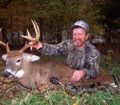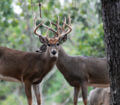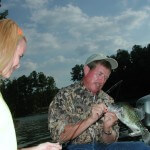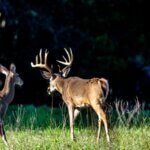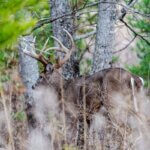Editor’s Note: Professional deer hunters and biologists know the old adage that bucks don’t move in hot and warm weather isn’t true. Bucks have to feed, bed and water, regardless of the temperature. Bucks just move very little in warmer weather. As the world experiences global warming, some of us will have to learn to hunt for hot and warm weather bucks during bow season. In Alabama, my home state, often at the first of bow season in mid-October, the temperature will hover around 90+ degrees.
Wesley Ashcraft of Birmingham, Ala., hunted just outside of town on his aunt’s small farm. Some years ago he noticed a deer trail that led from an old garden spot through Johnson grass back to a small creek. A 2-year-old clear cut bordered a 30- to 40-yard stretch of hardwoods through which a small creek ran. Ashcraft had taken a stand in a tree half-way between the old garden and the creek bottom the year before during rifle season. He had seen bucks moving along the creek bottom but never could get a shot. The bucks never used the trail leading from the garden spot back to the creek bottom during daylight hours.
The following summer Ashcraft had an idea about how to bag a buck with his bow. He knew he needed to get the deer in close. He bush-hogged a 6-foot wide path from the old garden spot past the tree where he placed his tree stand. A month before bow season, he noticed tracks along the path he had cut.
 Ashcraft never had hunted deer with a bow before that deer season. But on opening day of bow season with temperatures in the 90s, he left work early and hurried to his aunt’s farm. According to Ashcraft, “Just before dark, I saw a storm coming. The sky was gray, and I spotted a big thunderhead in the distance. As the storm approached, I decided I shouldn’t remain in my tree until dark and get wet. I let my bow down. As I bent over to pick-up my bow, I looked through the bush and spotted a buck at the end of the bush-hogged trail I had cut. I couldn’t believe cutting the grass and providing a trail for bucks had worked.”
Ashcraft never had hunted deer with a bow before that deer season. But on opening day of bow season with temperatures in the 90s, he left work early and hurried to his aunt’s farm. According to Ashcraft, “Just before dark, I saw a storm coming. The sky was gray, and I spotted a big thunderhead in the distance. As the storm approached, I decided I shouldn’t remain in my tree until dark and get wet. I let my bow down. As I bent over to pick-up my bow, I looked through the bush and spotted a buck at the end of the bush-hogged trail I had cut. I couldn’t believe cutting the grass and providing a trail for bucks had worked.”
Ashcraft had practiced with his bow and felt confident to take a shot out to about 30 yards. He had planned a tree stand shot, not a shot from the ground. He hoped to take a spike or a 4 point. However, the buck in front of him and coming straight to him would score about 140 points on Boone and Crockett. A quartering wind blew from behind Ashcraft. As the buck approached, Ashcraft knew he would have to make the shot at 30 yards, or else the buck would smell him. The deer continued to close ground. Ashcraft began to doubt his bowhunting ability.
“I realized I only could have a head-on shot, and I didn’t want to make that shot,” Ashcraft commented later. “I knew if the buck kept coming, he’d be so close I couldn’t miss him. But I thought I had watched the buck for so long and had had so long to think about the shot that I’d still probably miss. At least 100-different things went through my mind as the deer headed my way.”
Preparing for the head-on shot, Ashcraft drew his bow and began to rise-up just over the cover. He had to move some limbs out of the way to take the shot. When the buck reached 30-yards away, fate dealt Ashcraft a winning hand.
“The wind changed direction and started blowing straight from behind the buck,” Ashcraft reports. “I knew he couldn’t smell me. He kept coming straight to me.”
 When at full draw and looking through his peep sight, Ashcraft suddenly couldn’t see when a leaf fell between his peep and his sight. Although he had to move a limb on the bush, his luck held. Just as he got a clear sight picture of the buck, the animal, only 15-yards away, turned broadside. Then the big buck presented Ashcraft with a dream shot as the buck quartered-away and almost stood still when Ashcraft loosed the arrow. The buck jumped, ran about 25 yards and piled-up in a heap. Ashcraft took his trophy of a lifetime on his very-first bow hunt and utilized a strategy many warm-weather hunters employ throughout the nation of cutting trails through grass.
When at full draw and looking through his peep sight, Ashcraft suddenly couldn’t see when a leaf fell between his peep and his sight. Although he had to move a limb on the bush, his luck held. Just as he got a clear sight picture of the buck, the animal, only 15-yards away, turned broadside. Then the big buck presented Ashcraft with a dream shot as the buck quartered-away and almost stood still when Ashcraft loosed the arrow. The buck jumped, ran about 25 yards and piled-up in a heap. Ashcraft took his trophy of a lifetime on his very-first bow hunt and utilized a strategy many warm-weather hunters employ throughout the nation of cutting trails through grass.
Creatures of habit, deer prefer to take the path of least resistance when they move from one location to another. Since deer stay and move in thick cover during hot weather, many bowhunters have learned they can cause deer to pass by their tree stands by cutting paths through that thick cover for the deer to travel. You actually can funnel deer in to your tree stand by cutting trails the length or the breadth of the cover. You can make deer leave one trail and walk your man-made trail, if your trail allows deer to move through thick cover easier than the trail the deer already has established. In hot weather when thick-cover regions have plenty of food, the deer don’t have to come out of the cover to feed. If you can make paths that allow the deer to walk in thick cover easier, you’ll often cause deer to come to you.
To learn more about hunting deer, see John E. Phillips’ book at https://johninthewild.com/books/#deer for Kindle, print and Audible books, as well as some Nook books.

